The Baltimore Ravens still have a few days to work things out with respect to their salary cap now that they understand they will have to accommodate a $32.4 million expenditure for the time being with quarterback Lamar Jackson’s franchise tag.
While they already had roughly $20 million or so in cap space, it wasn’t nearly enough just to become compliant. They already traded veteran starting safety Chuck Clark to the New York Jets in a salary dump move that saved them about $3.5 million after displacement.
In another cap-creating move, they restructured the contract of veteran defensive tackle Michael Pierce, not only turning his money due into a signing bonus but also requesting and receiving a pay cut. Tom Pelissero reported that he agreed to cut his compensation in half from $4 million to $2 million in order to keep his job (because why else would he agree to it?). In all, it cleared a little more than $2.5 million in cap space.
But they’ve still got a ways to go, estimated to be a few million over the cap at this point even with the moves that have already been made. Not that they don’t have many ways of doing so between now and then, even if they would rather not.
They can restructure the contract of tackle Ronnie Stanley, for example, who is due $12.5 million in 2023. With three years left on his deal, they could create a good deal of room. They could turn $11,335,000 of his base salary into a signing bonus, which they could then spread out over three years, creating $7,556,667 in cap space for 2023.
That one move would make them cap compliant, but there may be other courses of action they would rather take at the moment, as that is a move they can always make at a later date. I can’t help but wonder if they really believe Calais Campbell is still worth $7 million, for example—but I suspect they do.
Just think what they would have had to do to accommodate the exclusive franchise tender of $45 million, if we’re going to be realistic. They would be about $15 million away from cap compliance right now if they took that path.
And obviously this is a scenario they had been discussing for a year or so, no doubt. It was always a possibility that they would end up in this position, they knew, going down the franchise tag route. Now they’re here, and they have to do what needs to be done.
The loss of Clark is significant, but not unpredictable. After all, they drafted safety Kyle Hamilton in the first round last year and he was likely hoped to take on the starting role this season anyway. Clark, however, was a leader on and off the field and his absence will be felt, but in the end it was a move best for both parties under the circumstances.








